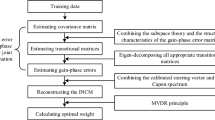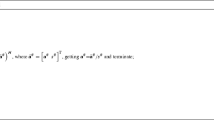Abstract
Compared with state-of-the-art robust adaptive beamforming methods, the recently developed steering vector estimation-based beamformer and interference-plus-noise covariance matrix reconstruction-based beamformer are known to provide better robustness against model mismatch. However, both methods may suffer from performance degradation in presence of antenna array geometry error. To alleviate this problem, a novel algorithm is proposed in this paper. In contrast to previous works, the true desired signal steering vector is estimated by solving a new optimization problem, the objective function of which is minimizing the beamformer sensitivity, while the constraint of which is obtained by optimizing the worst-case performance of the constraint adopted in conventional steering vector estimation-based method. We show that the solution of the newly constructed optimization problem can be obtained in closed form by using the Lagrange multiplier methodology, which has a comparable computational complexity with that of the standard Capon beamformer. Subsequently, the precise interference-plus-noise covariance matrix is reconstructed by eliminating the estimated desired signal component from the sample covariance matrix, which mitigates computational burden and accumulated errors induced by the integration process employed in the conventional covariance matrix reconstruction-based method. Owing to the high accuracy of estimated and reconstructed results, the proposed robust adaptive beamforming algorithm can maintain satisfactory performance in cases with imprecise array geometry. Simulation results verify that the proposed method outperforms the existing ones in many scenarios.






Similar content being viewed by others
Explore related subjects
Discover the latest articles, news and stories from top researchers in related subjects.References
Capon, J. (1969). High-resolution frequency-wavenumber spectrum analysis. Proceedings of the IEEE, 57(8), 1408–1418.
Cox, H., Zeskind, R. M., & Owen, M. H. (1987). Robust adaptive beamforming. IEEE Transactions on Acoustics, Speech, and Signal Processing, 35(10), 1365–1376.
Fabrizio, G. A., Gray, D. A., & Turley, M. D. (2003). Experimental evaluation of adaptive beamforming methods and interference models for high frequency over-the-horizon radar systems. Multidimensional Systems and Signal Processing, 14(1–3), 241–263.
Feldman, D., & Griffiths, L. (1994). A projection approach for robust adaptive beamforming. IEEE Transactions on Signal Processing, 42(4), 867–876.
Gershman, A. B. (1999). Robust adaptive beamforming in sensor arrays. International Journal of Electronics and Communications, 53(12), 305–314.
Gu, Y. J., Goodman, N. A., Hong, S. H., & Li, Y. (2014). Robust adaptive beamforming based on interference covariance matrix sparse reconstruction. Signal Processing, 96, 375–381.
Gu, Y. J., & Leshem, A. (2012). Robust adaptive beamforming based on interference covariance matrix reconstruction and steering vector estimation. IEEE Transactions on Signal Processing, 60(7), 3881–3885.
Hassanien, A., Vorobyov, S. A., & Wong, K. M. (2008). Robust adaptive beamforming using sequential quadratic programming: An iterative solution to the mismatch problem. IEEE Signal Processing Letters, 15, 733–736.
Khabbazibasmenj, A., Vorobyov, S. A., & Hassanien, A. (2012). Robust adaptive beamforming based on steering vector estimation with as little as possible prior information. IEEE Transactions on Signal Processing, 60(6), 2974–2987.
Li, J., Stoica, P., & Wang, Z. S. (2003). On robust capon beamforming and diagonal loading. IEEE Transactions on Signal Processing, 51(7), 1702–1715.
Li, J., & Stoica, P. (2005). Robust adaptive beamforming. New York, USA: Wiley.
Rübsamen, M., & Pesavento, M. (2013). Maximally robust capon beamformer. IEEE Transactions on Signal Processing, 61(5–8), 2030–2041.
Tu, L., & Ng, B. P. (2014). Exponential and generalized Dolph-Chebyshev functions for flat-top array beampattern synthesis. Multidimensional Systems and Signal Processing, 25(3), 541–561.
Van Trees, H. L. (2002). Optimum array processing. Hoboken, NJ: Wiley.
Van Veen, B., & Buckley, K. (1988). Beamforming: A versatile approach to spatial filtering. IEEE ASSP Magazine, 5(2), 4–24.
Vorobyov, S. A., Gershman, A. B., & Luo, Z. Q. (2003). Robust adaptive beamforming using worst-case performance optimization: A solution to the signal mismatch problem. IEEE Transactions on Signal Processing, 51(2), 313–324.
Vorobyov, S. A. (2013). Principles of minimum variance robust adaptive beamforming design. Signal Processing, 93(12), 3264–3277.
Zhuang, J., & Manikas, A. (2013). Interference cancellation beamforming robust to pointing errors. IET Signal Processing, 7(2), 120–127.
Acknowledgments
This work has been supported by: (1) the National Science Foundation of China under Grants 61231027, 61271292, and 61431016; (2) the Fundamental Research Funds of the Central Universities.
Author information
Authors and Affiliations
Corresponding author
Appendix
Appendix
In order to establish such an aforementioned compact constraint, we assume that the desired signal is located in the known angular sector of \(\Theta =\left[ {\theta _{\min } ,\theta _{\max } } \right] \) which is distinguishable from general locations of the interfering signals. It is indicated in Khabbazibasmenj et al. (2012) that \({\varvec{d}}^{H}\left( \theta \right) \tilde{{\varvec{C}}}{\varvec{d}}\left( \theta \right) =\Delta _0 \) will evidently occur on the boundary of \(\Theta \), i.e., \(\Delta _0 =\max \left\{ {{\varvec{d}}^{H}\left( {\theta _{\min } } \right) \tilde{{\varvec{C}}}{\varvec{d}}\left( {\theta _{\min } } \right) ,{{\varvec{d}}^H}\left( {\theta _{\max } } \right) \tilde{{\varvec{C}}}{\varvec{d}}\left( {\theta _{\max } } \right) } \right\} \). However, throughout our numerical experiments, it is worth noting that \({\varvec{d}}^{H}\left( {\theta _{\min } } \right) \tilde{{\varvec{C}}}{\varvec{d}}\left( {\theta _{\min } } \right) \) is approximately equal to \({\varvec{d}}^{H}\left( {\theta _{\max } } \right) \tilde{{\varvec{C}}}{\varvec{d}}\left( {\theta _{\max } } \right) \), thus \(\Delta _0 \) can be substituted by \({\varvec{d}}^{H}\left( {\theta _{\min } } \right) \tilde{{\varvec{C}}}{\varvec{d}}\left( {\theta _{\min } } \right) \) or \({\varvec{d}}^{H}\left( {\theta _{\max } } \right) \tilde{{\varvec{C}}}{\varvec{d}}\left( {\theta _{\max } } \right) \). According to above analysis, \(\Delta _1 \) in (10) can also be simplified as \(\min \limits _{\left\| {\varvec{\varDelta }} \right\| \le \eta } \left\| {\left( {{\varvec{Q}}+{\varvec{\varDelta }} } \right) {\varvec{d}}\left( {\theta _{\min } } \right) } \right\| ^{2}\). To promote further simplification, two different cases should be considered.
First, in the case that \(\left\| {{\varvec{Qd}}\left( {\theta _{\min } } \right) } \right\| \le \eta \left\| {{\varvec{d}}\left( {\theta _{\min } } \right) } \right\| \), by choosing \({{\varvec{\varDelta }}}^\prime =-{\varvec{Qd}}\left( {\theta _{\min } } \right) {\varvec{d}}^{H}\left( {\theta _{\min } } \right) /\left\| {{\varvec{d}}\left( {\theta _{\min } } \right) } \right\| ^{2}\), the matrix product \({{\varvec{\varDelta }} }^\prime {\varvec{d}}\left( {\theta _{\min }} \right) \) is equal to \(-{\varvec{Qd}}\left( {\theta _{\min } } \right) \) and it is guaranteed that \(\left\| {{{\varvec{\varDelta }}}^\prime } \right\| \le \eta \). The latter can be confirmed as
where the last inequality is due to the assumption that \(\left\| {{\varvec{Qd}}\left( {\theta _{\min } } \right) } \right\| \le \eta \left\| {{\varvec{d}}\left( {\theta _{\min } } \right) } \right\| \). Using such \({{\varvec{\varDelta }} }^\prime ,\,\Delta _1 \) in (10) becomes equal to zero.
Next, we consider the case that \(\left\| {{\varvec{Qd}}\left( {\theta _{\min } } \right) } \right\| >\eta \left\| {{\varvec{d}}\left( {\theta _{\min } } \right) } \right\| \). In this case, by choosing \({{\varvec{\varDelta }}}^{\prime \prime }=-\eta {\varvec{Qd}}\left( {\theta _{\min } } \right) {\varvec{d}}^{H}\left( {\theta _{\min } } \right) /\left( {\left\| {{\varvec{Qd}}\left( {\theta _{\min } } \right) } \right\| \cdot \left\| {{\varvec{d}}\left( {\theta _{\min } } \right) } \right\| } \right) \), the vector \({\varvec{Qd}}\left( {\theta _{\min } } \right) \) is parallel to the vector \({{\varvec{\varDelta }}}^{\prime \prime }{\varvec{d}}\left( {\theta _{\min } } \right) \), and \(\left\| {{{\varvec{\varDelta }}}^{\prime \prime }{\varvec{d}}\left( {\theta _{\min } } \right) } \right\| =\eta {\varvec{d}}\left( {\theta _{\min } } \right) \) (it can be verified by following similar steps as in (30)). Since \(\left\| {{\varvec{\varDelta }} {\varvec{d}}\left( {\theta _{\min } } \right) } \right\| \le \left\| {\varvec{\varDelta }} \right\| \cdot \left\| {{\varvec{d}}\left( {\theta _{\min } } \right) } \right\| \le \eta \left\| {{\varvec{d}}\left( {\theta _{\min } } \right) } \right\| \) (it can be easily derived by using Cauchy-Schwarz inequality), we can conclude that \({{\varvec{\varDelta }}}^{\prime \prime }{\varvec{d}}\left( {\theta _{\min } } \right) \) is parallel to \({\varvec{Qd}}\left( {\theta _{\min } } \right) \) and it has the largest possible magnitude. Then we can resort to triangular inequality and Cauchy-Schwarz inequality in order to obtain the following inequality chain
Due to the fact that \({{\varvec{\varDelta }}}^{\prime \prime }{\varvec{d}}\left( {\theta _{\min } } \right) \) is parallel to \({\varvec{Qd}}\left( {\theta _{\min } } \right) \) and it has the largest possible magnitude, the inequalities in (31) are active when \({\varvec{\varDelta }} ={{\varvec{\varDelta }} }^{\prime \prime }\), i.e., the equalities hold, so the value of \(\Delta _1 \) in this case becomes \(\left( {\left\| {{\varvec{Qd}}\left( {\theta _{\min } } \right) } \right\| -\eta \left\| {{\varvec{d}}\left( {\theta _{\min } } \right) } \right\| } \right) ^{2}\).
We emphasize that the first case mentioned above should be excluded because it is in contradiction with the fact that the left side of the inequality constraint in (10) is always a positive value. Following the similar analytical procedure to derive the simplified form of \(\Delta _1 \), the expression \(\max \limits _{\left\| {\varvec{\varDelta }} \right\| \le \eta } \tilde{{\varvec{a}}}^{H}\left( {{\varvec{Q}}+{\varvec{\varDelta }} } \right) ^{H}\left( {{\varvec{Q}}+{\varvec{\varDelta }}} \right) \tilde{{\varvec{a}}}\) in (10) can be recast as \(\left( {\left\| {{\varvec{Q}}\tilde{{\varvec{a}}}} \right\| +\eta \left\| {\tilde{{\varvec{a}}}} \right\| } \right) ^{2}\).
Rights and permissions
About this article
Cite this article
Yang, J., Liao, G., Li, J. et al. Robust beamforming with imprecise array geometry using steering vector estimation and interference covariance matrix reconstruction. Multidim Syst Sign Process 28, 451–469 (2017). https://doi.org/10.1007/s11045-015-0350-7
Received:
Revised:
Accepted:
Published:
Issue Date:
DOI: https://doi.org/10.1007/s11045-015-0350-7




